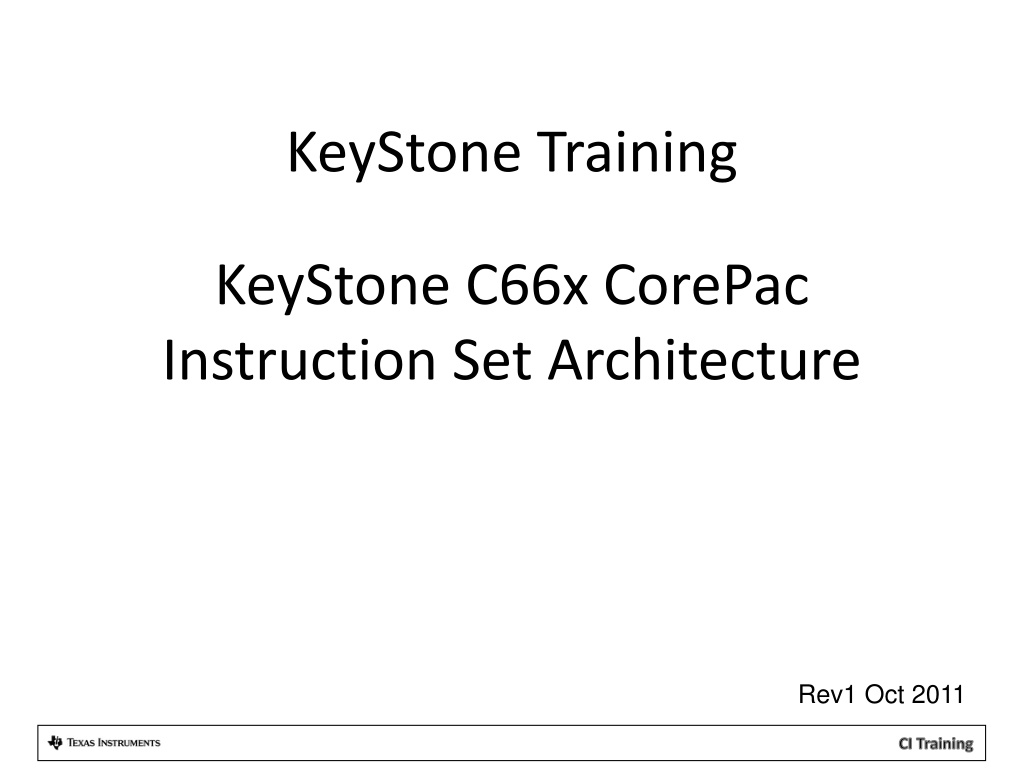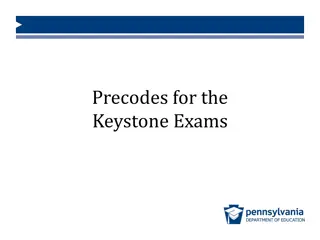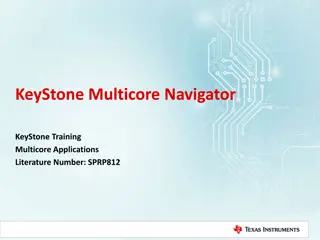KeyStone Training
In this training, explore the differences between the TMS320C674x and TMS320C66x instruction set architectures included in the KeyStone CorePac. Dive into enhanced SIMD and floating-point capabilities, DSP core improvements, CPU modifications, and the evolution of the core architecture. Understand the increased performance, unified architecture, advanced fixed-point and floating-point instructions, and more innovations for better system performance and efficiency.
Download Presentation

Please find below an Image/Link to download the presentation.
The content on the website is provided AS IS for your information and personal use only. It may not be sold, licensed, or shared on other websites without obtaining consent from the author.If you encounter any issues during the download, it is possible that the publisher has removed the file from their server.
You are allowed to download the files provided on this website for personal or commercial use, subject to the condition that they are used lawfully. All files are the property of their respective owners.
The content on the website is provided AS IS for your information and personal use only. It may not be sold, licensed, or shared on other websites without obtaining consent from the author.
E N D
Presentation Transcript
KeyStone Training KeyStone C66x CorePac Instruction Set Architecture Rev1 Oct 2011 CI Training
Disclaimer This section describes differences between the TMS320C674x instruction set architecture and the TMS320C66x instruction set included in the KeyStone CorePac. Users of this training should already be familiar with the TMS320C674x CPU and Instruction Set Architecture. CI Training
Agenda Introduction Increased SIMD Capabilities C66x Floating-Point Capabilities Examples of New Instructions Matrix Multiply Example CI Training
Introduction Introduction Increased SIMD Capabilities C66x Floating-Point Capabilities Examples of New Instructions Matrix Multiply Example CI Training
Enhanced DSP Core C66x CorePac Performance improvement 100% upward object code compatible 4x performance improvement for multiply operation 32 16-bit MACs Improved support for complex arithmetic and matrix computation C64x+ C67x+ 100% upward object code compatible with C64x, C64x+, C67x and c67x+ SPLOOP and 16-bit instructions for smaller code size C64x C67x 2x registers Advanced fixed- point instructions Best of fixed-point and floating-point architecture for better system performance and faster time-to-market Native instructions for IEEE 754, SP&DP Flexible level one memory architecture Four 16-bit or eight 8-bit MACs Enhanced floating-point add capabilities iDMA for rapid data transfers between local memories Advanced VLIW architecture Two-level cache FLOATING-POINT VALUE FIXED-POINT VALUE CI Training
CPU Modifications Datapaths of the .L and .S units have been increased from 32-bit to 64-bit. Datapaths of the .M units have been increased from 64-bit to 128-bit. The cross-path between the register files has been increased from 32-bit to 64-bit. Register file quadruplets are used to create 128-bit values. No changes in D datapath. CI Training
Core Evolution Unified Architecture Increased Performance Fixed/Floating Unification C64x+ .M C64x+ .D .L .D .L 16x16 MPY 16x16 MPY C64x+ multiplier unit contains four 16-bit multipliers (per side) Register File Register File 16x16 MPY 16x16 MPY 16 fixed multiplies per cycle (per side) .S .M .S .M Adders B A 32b Crosspath .M C66x Four floating multiplies per cycle (per side) Float Float C66x 16x16 MPY 16x16 MPY 16x16 MPY 16x16 MPY .D .L .D .L 16x16 MPY 16x16 MPY 16x16 MPY 16x16 MPY Register File Register File 16x16 MPY 16x16 MPY 16x16 MPY 16x16 MPY .S .M .S .M B A 16x16 MPY 16x16 MPY 16x16 MPY 16x16 MPY Diagram Key .D = Data Unit .M = Multiplier Unit .L = Logical Unit .S = Shifter Unit Float Float Adders 64b Crosspath CI Training
Increased Performance Floating-point and fixed-point performance is significantly increased. 4x increase in the number of MACs Fixed-point core performance: 32 (16x16-bit) multiplies per cycle. Eight complex MACs per cycle Floating-point core performance: Eight single-precision multiplies per cycle Four single-precision MACs per cycle Two double-precision MACs per cycle SIMD (Single Instruction Multiple Data) support Additional resource flexibility (e.g., the INT to/from SP conversion operations can now be executed on .L and .S units). Optimized for complex arithmetic and linear algebra (matrix processing) L1 and L2 processing is highly dominated by complex arithmetic and linear algebra (matrix processing). CI Training
Performance Improvement Overview C64x+ C674x C66x Fixed point 16x16 MACs per cycle 8 8 32 Fixed point 32x32 MACs per cycle 2 2 8 Floating point single-precision MACs per cycle n/a 2 8 Arithmetic floating-point operations per cycle n/a 6 1 16 2 Load/store width 2 x 64-bit 2 x 64-bit 2 x 64-bit 128-bit 3 Vector size 32-bit 32-bit (4 x 32-bit, 4 x 16-bit, 4 x 8-bit) (SIMD capability) (2 x 16-bit, 4 x 8-bit) (2 x 16-bit, 4 x 8-bit) [1] One operation per .L, .S, .M units for each side (A and B) [2] Two-way SIMD on .L and .S units (e.g., 8 SP operations for A and B) and 4 SP multiply on one .M unit (e.g., 8 SP operations for A and B). [3] 128-bit SIMD for the M unit. 64-bit SIMD for the .L and .S units. CI Training
Increased SIMD Capabilities Introduction Increased SIMD Capabilities C66x Floating-Point Capabilities Examples of New Instructions Matrix Multiply Example CI Training
SIMD Instructions C64x and C674x support 32-bit SIMD: 2 x 16-bit Syntax: <instruction_name>2 .<unit> <operand> Example: MPY2 4 x 8-bit Syntax: <instruction_name>4 .<unit> <operand> Example: AVGU4 C66x improves SIMD support: Two-way SIMD version of existing instruction: Syntax: D<instruction_name> .<unit> <operand> Example: DMPY2, DADD CI Training
SIMD C66x supports various SIMD data types: 2 x 16-bit Two-way SIMD operations for 16-bit elements Example: ADD2 2 x 32-bit Two-way SIMD operations for 32-bit elements Example: DSUB Two-way SIMD operations for complex (16-bit I / 16-bit Q) elements Example: DCMPY Two-way SIMD operations for single-precision floating elements Example: DMPYSP 4 x 16-bit Four-way SIMD operations for 16-bit elements Example: DMAX2, DADD2 4 x 32-bit Four-way SIMD operations for 32-bit elements Example: QSMPY32R1 Four-way SIMD operations for complex (16-bit I / 16-bit Q) elements Example: CMATMPY Four-way SIMD operations for single-precision floating elements Example: QMPYSP 8 x 8-bit Eight-way SIMD operations for 8-bit elements Example: DMINU4 Data Types CI Training
SIMD Operations (1/2) Same precision Examples: MAX2 DADD2 DCMPYR1 y-bit A(3) A(2) A(1) A(0) B(3) B(2) B(1) B(0) op op op op C(3) C(2) C(1) C(0) 4 x y-bit Increased/narrowed precision Example: DCMPY y-bit A(3) A(2) A(1) A(0) B(3) B(2) B(1) B(0) op op op op C(3) C(3) C(3) C(3) 4 x z-bit CI Training
SIMD Operations (2/2) Reduction Example: DCMPY, DDOTP4H y-bit A(3) A(2) A(1) A(0) B(3) B(2) B(1) B(0) op op op op op op C(1) C(0) 4 x z-bit y-bit A(3) A(2) A(1) A(0) B(0) Complex instructions Example: DDOTPxx, CMATMPY B(1) Multiple operations (with possible data re-use) with possible data reuse Multiple operations B(2) B(3) C(3) C(2) C(1) C(0) 4 x z-bit CI Training
Registers and Data Types Introduction Increased SIMD Capabilities Registers and Data Types C66x Floating-Point Capabilities Examples of New Instructions Matrix Multiply Example CI Training
Registers C66x provides a total of 64 32-bit registers, which are organized in two general purpose register files (A and B) of 32 registers each. Register File A B A1:A0 A3:A2 A5:A4 A7:A6 A9:A8 A11:A10 A13:A12 A15:A14 A17:A16 A19:A18 A21:A20 A23:A22 A25:A24 A27:A26 A29:A28 A31:A30 B1:B0 B3:B2 B5:B4 B7:B6 B9:B8 B11:B10 B13:B12 B15:B14 B17:B16 B19:B18 B21:B20 B23:B22 B25:B24 B27:B26 B29:B28 B31:B30 Registers can be accessed as follows: Registers (32-bit) Register pairs (64-bit) Register quads (128-bit) Register File A B A3:A2:A1:A0 A7:A6:A5:A4 A11:A10:A9:A8 A15:A14:A13:A12 A19:A18:A17:A16 A23:A22:A21:A20 A27:A26:A25:A24 A31:A30:A29:A28 B3:B2:B1:B0 B7:B6:B5:B4 B11:B10:B9:B8 B15:B14:B13:B12 B19:B18:B17:B16 B23:B22:B21:B20 B27:B26:B25:B24 B31:B30:B29:B28 C66x provides explicit aliased views. CI Training
The __x128_t Container Type (1/2) To manipulate 128-bit vectors, a new data type has been created in the C compiler: __x128_t. C compiler defines some intrinsic to create 128-bit vectors and to extract elements from a 128-bit vector. CI Training
The __x128_t Container Type (2/2) Example: Extraction Creation _get32_128(src, 0) _llto128(src1,src2) _ito128(src1,src2,src3, src4) _hi128(src) Refer to the TMS320C6000 Optimizing Compiler User Guide for a complete list of available intrinsics to create 128-bit vectors and extract elements from a 128-bit vector. CI Training
The __float2_t Container Type C66x ISA supports floating-point SIMD operations. __float2_t is a container type to store two single precision floats. On previous architectures (C67x, C674x) , the double data type was used as a container for SIMD float numbers. While all old instructions can still use the double data type, all new C66x instructions will have to use the new data type: __float2_t. The C compiler defines some intrinsic to create vectors of floating- point elements and to extract floating-point elements from a floating-point vector. Extraction Creation _lof2(src) _ftof2(src1,src2) CI Training
C66x Floating Point Capabilities Introduction Increased SIMD Capabilities Register C66x Floating-Point Capabilities Examples of New Instructions Matrix Multiply Example CI Training
Support for Floating Point in C66x Floating point enables efficient MIMO processing and LTE scheduling: C66x core supports floating point at full clock speed resulting in 20 GFlops per core @ 1.2GHz. Floating point enables rapid algorithm prototyping and quick SW redesigns, thus there is no need for normalization and scaling. Use Case: LTE MMSE MIMO receiver kernel with matrix inversion Performs up to 5x faster than fixed-point implementation Significantly reduces development and debug cycle time ~1 day ~3 months Fixed-Point Algorithm (ASM, C, C++) Fixed- Point DSP Floating-Point Algorithm (C or C++) Floating- Point DSP Floating point significantly reduces design cycle time with increased performance CI Training
C66x Floating-Point Compatibility C66x is 100% object code compatible with C674x. A new version of each basic floating-point instruction has been implemented. C674x C66x Delay Slots Functional Unit Latency Delay Slot Functional Unit Latency MPYSP 3 1 3 1 ADDSP / SUBSP 3 1 2 1 MPYDP 9 4 3 1 ADDDP/SUBDP 6 2 2 1 The C compiler automatically selects the new C66x instructions. When writing in hand-coded assembly, the Fast version has to be specifically used. FADDSP / FSUBSP / FMPYSP / FADDSP / FSUBSP / FMPYSP CI Training
C66x Floating Point C66x ISA includes a complex arithmetic multiply instruction, CMPYSP. CMPYSP computes the four partial products of the complex multiply. To complete a full complex multiply in floating point, the following code has to be executed: CMPYSP .M1 A7:A6, A5:A4, A3:A2:A1:A0 ; partial products DADDSP .M1 A3:A2, A1:A0, A31:A30 ; Add the partial products. CI Training
Examples of New Instructions Introduction Increased SIMD Capabilities C66x Floating-Point Capabilities Examples of New Instructions Matrix Multiply Example CI Training
New Instructions on .M Unit C/C++ Compiler Intrinsic Assembly Instruction Description Two-way SIMD complex multiply operations on two sets of packed numbers. DCMPY __x128_t _dcmpy(long long src1, long long src2); Two-way SIMD complex multiply operations on two sets of packed numbers with complex conjugate of src2. DCCMPY __x128_t _dccmpy(long long src1, long long src2); Two-way SIMD complex multiply operations on two sets of packed numbers with rounding. DCMPYR1 long long _dcmpy(long long src1, long long src2); Two-way SIMD complex multiply operations on two sets of packed numbers with rounding and complex conjugate of src2. DCCMPYR1 long long _dccmpy(long long src1, long long src2); Multiply a 1x2 vector by one 2x2 complex matrix, producing two 32-bit complex numbers. CMATMPY __x128_t _cmatmpy(long long src1, __x128_tsrc2); Multiply the conjugate of a 1x2 vector by one 2x2 complex matrix, producing two 32-bit complex numbers. CCMATMPY __x128_t _ccmatmpy(long long src1, __x128_t src2); Multiply a 1x2 vector by one 2x2 complex matrix, producing two 32-bit complex numbers with rounding CMATMPYR1 long long _cmatmpyr1(long long src1, __x128_tsrc2); Multiply the conjugate of a 1x2 vector by one 2x2 complex matrix, producing two 32-bit complex numbers with rounding. CCMATMPYR1 long long _ccmatmpyr1(long long src1, __x128_t src2); Four-way SIMD multiply, packed signed 16-bit DMPY2 __x128_t _dmpy2 (long long src1, long long src2); Four-way SIMD multiply signed by signed with left shift and saturation, packed signed 16-bit DSMPY2 __x128_t _dsmpy2 (long long src1, long long src2); CI Training
New Instructions on .M Unit C/C++ Compiler Intrinsic Assembly Instruction Description Expands bits to packed 16-bit masks DXPND2 long long _dxpnd2 (unsigned src); 32-bit complex conjugate multiply of Q31 numbers with Rounding CCMPY32R1 long long _ccmpy32r1 (long long src1, long long src2); Four-way SIMD 32-bit single precision multiply producing four 32-bit single precision results. QMPYSP __x128_t _qmpysp (__x128_t src1, __x128_t src2); Four-way SIMD multiply of signed 32-bit values producing four 32-bit results. (Four-way _mpy32). QMPY32 __x128_t _qmpy32 (__x128_t src1, __x128_t src2); 4-way SIMD fractional 32-bit by 32-bit multiply where each result value is shifted right by 31 bits and rounded. This normalizes the result to lie within -1 and 1 in a Q31 fractional number system. QSMPY32R1 __x128_t _qsmpy32r1 (__x128_t src1, __x128_t src2); CI Training
New Instructions on .L Unit C/C++ Compiler Intrinsic Assembly Instruction Description Shift-right of two signed 32-bit values by a single value in the src2 argument. DSHR long long _dshr(long long src1, unsigned src2); Shift-right of two unsigned 32-bit values by a single value in the src2 argument. DSHRU long long _dshru(long long src1, unsigned src2); Shift-left of two signed 32-bit values by a single value in the src2 argument. DSHL long long _dshl(long long src1, unsigned src2); Shift-right of four signed 16-bit values by a single value in the src2 argument (two way _shr2(), four way SHR). DSHR2 long long _dshr2(long long src1, unsigned src2); Shift-right of four unsigned 16-bit values by a single value in the src2 argument (two way _shru2(), four way SHRU). DSHRU2 long long _dshru2(long long src1, unsigned src2); Shift-left of two signed 16-bit values by a single value in the src2 argument. SHL2 unsigned _shl2(unsigned src1, unsigned src2); Shift-left of four signed 16-bit values by a single value in the src2 argument (two way _shl2(), four way SHL). DSHL2 long long _dshl2(long long src1, unsigned src2); Four-way SIMD comparison of signed 16-bit values. Results are packed into the four least significant bits of the return value. DCMPGT2 unsigned _dcmpgt2(long long src1, long long src2); Four-way SIMD comparison of signed 16-bit values. Results are packed into the four least significant bits of the return value. DCMPEQ2 unsigned _dcmpeq2(long long src1, long long src2); Stall CPU while memory system is busy. MFENCE void _mfence(); CI Training
New Instructions on .L/.S Unit C/C++ Compiler Intrinsic Assembly Instruction Description Two-way SIMD addition of 32-bit single precision numbers. DADDSP Double _daddsp(double src1, double src2); Two-way SIMD subtraction of 32-bit single precision numbers. DSUBSP Double _dsubsp(double src1, double src2); Converts two 32-bit signed integers to two single-precision float point values. DINTSP __float2_t _dintsp(long long src); Converts two packed single-precision floating point values to two signed 32-bit values. DSPINT long long _dspint (__float2_t src); CI Training
Other New Instructions For an exhaustive list of the C66x instructions, please refer to the Instruction Descriptions in the TMS320C66x DSP CPU and Instruction Set. For an exhaustive list of the new C66x instructions and their associated C intrinsics, please refer to the Vector-in-Scalar Support C/C++ Compiler v7.2 Intrinsics table in the TMS320C6000 Optimizing Compiler User Guide. CI Training
Matrix Multiply Example Introduction Increased SIMD Capabilities C66x Floating-Point Capabilities Examples of New Instructions Matrix Multiply Example CI Training
Matrix Multiply CI Training
Matrix Multiply CMATMPY instruction performs the basic operation: = 12 11 C C B B 11 12 . A A 11 12 B B 21 22 Multiple CMATMPY instructions can be used to compute larger matrices. CI Training
Matrix Multiply C66x C + intrinsic code: Use of the __x128_t type Use of some conversion intrinsic Use of _cmatmpyr1() intrinsic CI Training
Matrix Multiply C66x Implementation Description C66x C + intrinsic code: Most inner loop unrolled Construct a 128-bit vector from two 64-bit 128-bit vector data type Four-way SIMD saturated addition Matrix multiply operation with rounding CI Training
Matrix Multiply C66x Resources Utilization C compiler software pipelining feedback: The TI C66x C compiler optimizes this loop in four cycles. Perfect balance in the CPU resources utilization: Two 64-bit loads per cycle Two CMATMPY per cycle i.e., 32 16-bit x 16-bit multiplies per cycle Eight saturated additions per cycle. Additional examples are described in the application report, Optimizing Loops on the C66x DSP. CI Training
For More Information For more information, refer to the C66x DSP CPU and Instruction Set Reference Guide. For a list of intrinsics, refer to the TMS320C6000 Optimizing Compiler User Guide. For questions regarding topics covered in this training, visit the C66x support forums at the TI E2E Community website. CI Training






























